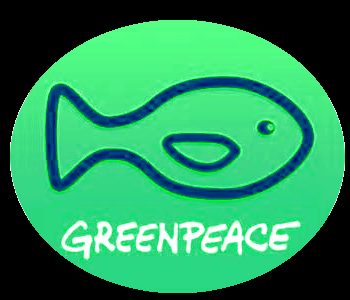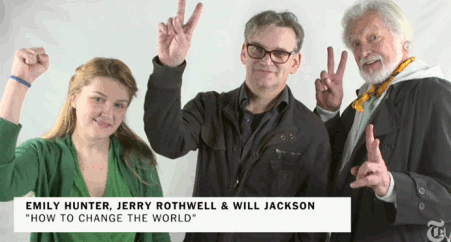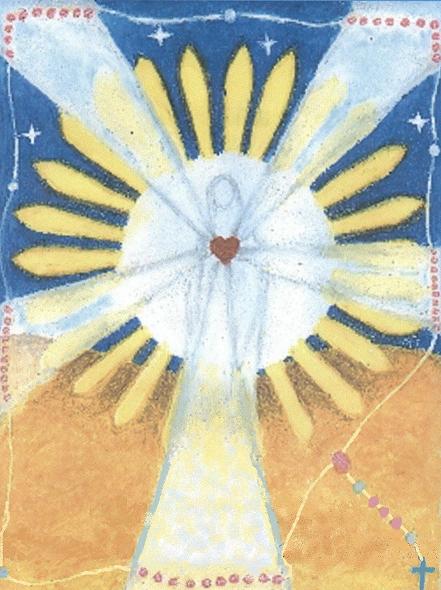When we try to pick out anything by itself, we find it hitched to everything else in the Universe.
--John Muir

India's Greenpeace Success!

A New Generation of Activism.
Art at its most significant is a Distant Early Warning System that can always be relied on to tell the old culture what is beginning to happen to it.
--Marshall McLuhan

REAL kids and Los Alamos scientists in 1985
Confronting Nuclearism In California
|
23 JANUARY, 2015; Wasatch Range Watershed
As a documentary filmmaker and spiritual eco-activist, I am grateful for the film How to Change The World, featuring Emily Hunter, the writings of her father Bob Hunter (narrated/read by Barry Pepper), and Bob's widow Bobbi Hunter. The film also contains intimate archival footage to flesh out this story of human masculine intensity leading the early Canadian Greenpeace movement. It could be re-titled as "Some Early Boatmen of Greenpeace" because it focuses on folks of the 1970s including Paul Watson, Patrick Moore, David Garrick, Bill Darnell & Rex Weyler. Environmental activists in the past half-century are still in the early stages of the "200-year cleanup" of this battle which humanity has already won against corporate eco-terrorists in advance of the chronological end of the nuclear age.
Despite the adept truthful storytelling of the interpersonal relationships of these men on boats, with a few women in-tow, this film in the context of the 21st Century's global climate crises and governmental terrorism is truly a tragic tale. The capacity for humans to joyfully ride the ecstatic flow of creative, life-affirming bold energy is thwarted again and again when we fail to humbly embrace our role as passionate partners with our environment. Indigenous spirituality and the impact of Saints Francis and Clare remind us that we are all related to each other as siblings in an enormous ecological family. Greenpeace is a global movement continuing to do good work, and this sad story seen last night in Park City on "Earth Day Monthly" was a prime demonstration of green anarchist hopes thwarted. The movie deftly articulates the difficulty of following the call to stop destroying our world, using media as a weapon in the war against capitalist greed.
Living creatures are being destroyed constantly by the global capitalist system, using individual person power. The U.S. Government and so many other groupings of dominators consistently keep the pressure up against the ecological systems on the surface of our planet, which have nicely sustained humanity until the present age. Contemporary eco-violence radiates hourly from domination systems such as the auto industry, the nuclear industry, the drone industry, the computer proliferation industry, and the genetic engineering industry. New organisms now inhabit the surface of our planet through genetic modification and extinction of pre-21st century creatures. Amidst the courageous masculine struggle to be good men stopping bad men from the industrialized slaughter of our ecological system, a lovely eco-spiritual lesson emerges in the first half of the film during the nuclear abolition and save-the-whales phase of Greenpeace.
With his head accepting the invitation into the whale's open mouth, and his terror at the point of the whale's teeth pressure gently hurting his body, Bob has an epiphany. The whale releases, apparently satisfied that Bob gets the point, or the points, literally and figuratively. This personal and political demonstration by the whale is articulated further when Bob quotes Ginsberg on what to do about power-over others: "let go of it before it freezes in your hands." The synthesis of these two elements in the film mean simply that the mutable energy of spiritual power is awesome and hot, and becomes power-over-others when undisciplined humans tame power (cool it down) into a solid weapon. The rest of the film demonstrates the tragedy of not learning the lesson. We must not thwart the awesome power of creative love in this universe. Lovarchy is supremely sweeter than any hierarchy of power, or patriarchy, or any oligarchy. Anarchy is only a simple bridge into such a lovarchy. Bob Hunter realizes mid-way through the movie that ecology is flow, "you and i are definitely part of the flow", everything we do effects the it and everything in the flow effects us.
|
ANOTHER SUPER-CLEAR VERSION OF THE FIVE STEPS TO CHANGE THE WORLD:
In the film, the neat narrative packaging says there's 5 steps to change the world:
1) Plant a mind-bomb.
2) Put your body where your mouth is.
3) Fear success
4) The revolution will not be organized.
5) Let the power go.
But, i would revise them:
If the lessons of the origins of Greenpeace are to be modeled, they should be:
1) Take a trip, possibly on a boat, perhaps on foot; make a pilgrimage of some sort.
2) Work simultaneously on your humility and empowerment plus your personal and our societal developments in nonviolence.
3) Put your body where your mouth is; take action, make direct actions, practice what you preach.
4) Facilitate the synergy of imagination, courage, passion, and skills so that all might contribute happily.
5) Explode a mind-bomb; set your project into the public sphere, and it WILL go viral.
Shut Down Creech (SDC) Video
Shut Down Creech: A Convergence For Peace
|


